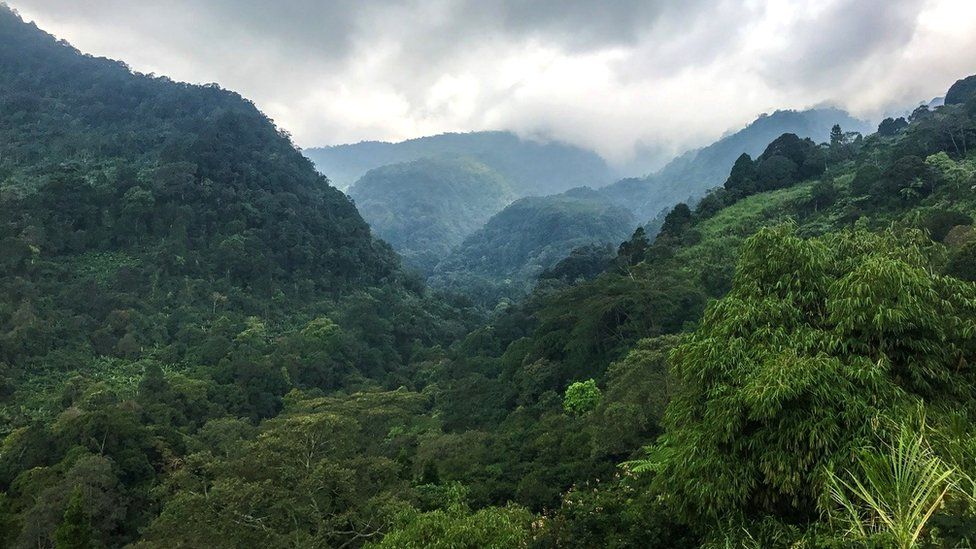ARTICLE AD BOX
This award-winning essay from young British science writer Zara Hussan explores the hidden, underground networks of fungi that are silently helping plants and trees to lock away carbon and combat climate change. Winner of the 2022 Association of British Science Writers (ABSW) Young Science Writer of the Year award, her essay explores a microscopic realm: Earth's fungal "life support system".
 Image source, Victoria Gill
Image source, Victoria Gill
A forest is home to billions of living things, some of them too small to be seen by the naked eye. Collectively, these micro-scale species contribute more to our planet than most of us could imagine.
While we know that forests play a major role in countering global warming - acting as reservoirs for carbon - what is less well understood is how tiny organisms that dwell hidden in the soil help lock away our greenhouse gas emissions.
The trees in our forests absorb carbon dioxide from the atmosphere as they photosynthesise; their leaves, powered by sunlight, convert that carbon dioxide into oxygen and sugar. As a tree grows, the carbon becomes part of its woody "biomass".
This is how trees naturally combat the planet-warming greenhouse effect. In the last 20 years, the Amazon rainforest alone is estimated to have taken in 1.7 billion metric tons of carbon dioxide.
Trees though do not act in isolation; they are entangled with - and working alongside - a vast community of micro-scale fungi.
A 2016 study led by researchers from Imperial College London revealed that one particular type - ectomycorrhizal fungi - enables certain trees to absorb CO2 faster (and therefore grow faster) than others. This is known as the "CO2 fertilisation effect".
These fungi live in the root system of a host tree. In a symbiotic relationship, fungi help the tree to absorb more water, carbon and other nutrients. In exchange, the tree provides food for the fungi by photosynthesising.
Ectomycorrhizal fungi have also been found to slow down the process of rotting; decomposition breaks down all that locked-away carbon and releases it into the atmosphere. So the fungi, in effect, have two methods of fighting global warming.
Insights into the critical, growth-boosting role of fungi have already been applied to agriculture. Seeding the soil with "friendly fungus" is considered a promising technology for future sustainable farming.
Research conducted into planting one particular variety - Arbuscular mycorrhizal fungi, or AMF - in soil has shown how it can not only help enrich soil fertility, but also reduce CO2 levels in the atmosphere.
Image source, Getty Images
Image caption,A mesh of underground fungi plays an important role in energy and nutrient recycling
Using these fungi can also provide a more sustainable alternative to chemical fertilisers, which can run into and pollute nearby water sources.
The benefits of so-called "biofertilisers", like AMF, have resulted in the global biofertiliser market reaching a value of more than $2bn.
Switching from chemical to biological fertilisers does comes at a financial cost. Biological fertilisers are also often crop-specific and they generally do not boost crop yield as much and as quickly as chemical fertilisers do. They are understood to be so much more beneficial for the soil and for the environment though that, in the UK, the government has developed a scheme called the Sustainable Farming Incentive (SFI). It aims to provide financial assistance to farmers who opt for more sustainable, nature-enhancing practices.
Moving away from chemical fertilisers on farmland could give those helpful fungi a boost in our forests, too.
Scientists say that naturally-occurring forest fungi are being put at risk by some chemicals. Dr Colin Averill, a senior scientist at ETH Zurich in Switzerland, says chemical fertilisers - that are rich in nitrogen, phosphorus and potassium - actually break down the symbiosis between fungi and plant roots.
Research has also shown a link between the loss of soil fungi and a reduction in carbon content of forest soil. Meanwhile, deforestation, which annihilates the fungi along with their host trees, disrupts this whole underground, climate change-fighting ecosystem.
The system can be repaired, though. Dr Averill says that, by transplanting soil from rich, biodiverse "donor" sites to sites where soil is depleted, it is possible to restore fungal networks.
He argues that taking these steps is necessary to help protect microbial communities.
More recently, a project led by the Society for the Protection of Underground Networks (Spun) has set out to map these microscopic fungal networks and to understand their essential role in protecting our soils. The project is the start of what scientists have called an "underground climate movement", aiming to protect this ancient life support system and to help it to help us fight climate change.
These fungi might be tiny and hidden beneath the ground, but they form a network that is protecting our planet. Scientists who study them say we can do more - particularly through sustainable farming methods - to protect them.
Young Science Writer of the year 2022, Zara Hussan, 14, is from Plashet School, East Ham, London. The ABSW Young Science Writer of the Year award invites students aged 14-16 years, to submit an 800-word essay. The competition, supported by BBC News, is designed to get young people writing and thinking about the big questions in science, technology, engineering and/or mathematics.

 2 years ago
28
2 years ago
28








 English (US) ·
English (US) ·